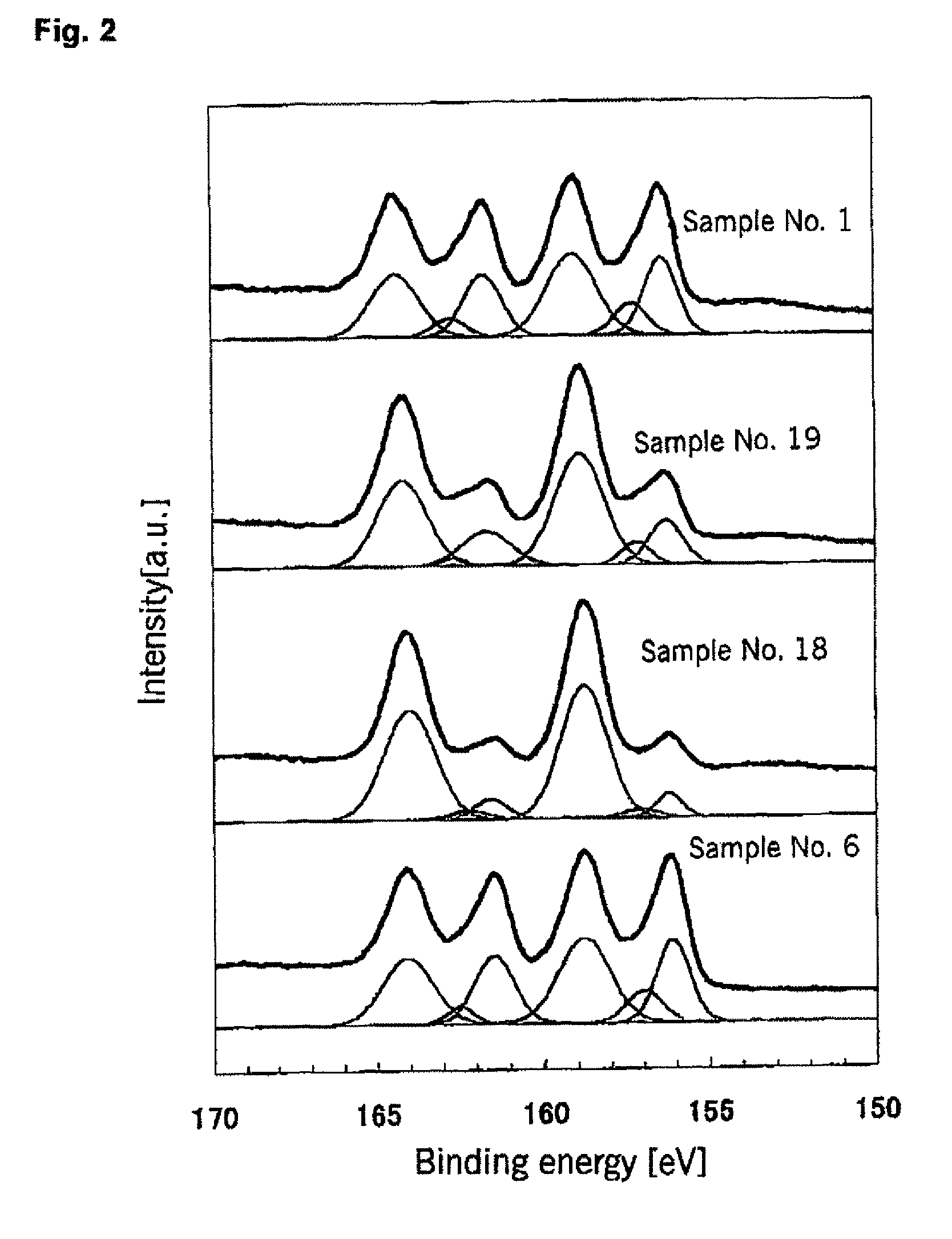Titanium oxide photocatalyst, method for producing same and use thereof
a technology of titanium oxide and photocatalyst, which is applied in the direction of physical/chemical process catalyst, metal/metal-oxide/metal-hydroxide catalyst, separation process, etc., can solve the problems of inability to mass production and decrease in overall photocatalytic activity, and achieve the effect of superior visible light photocatalytic performan
- Summary
- Abstract
- Description
- Claims
- Application Information
AI Technical Summary
Benefits of technology
Problems solved by technology
Method used
Image
Examples
example 1
Synthesis of a Titanium Oxide-based Photocatalyst
Sample No. 1:
[0132]An acidic aqueous solution containing 13.4 g of bismuth chloride (BiCl3) was slowly added dropwise to 216 g of a titanium tetrachloride (TiCl4) solution (Ti content 9.3 weight %), and after adequately stirring the resulting mixture, 9.7 g of liquid silicon tetrachloride (SiCl4) was added dropwise to the mixture.
[0133]While the resulting mixed aqueous solution of chlorides was stirred with ice cooling, a sufficient amount of an ammonia water (concentration of 7 weight %) for neutralization was added dropwise to the solution to hydrolyze the chlorides present therein, thereby causing the corresponding hydroxides to precipitate. The resulting precipitates which contained metal hydroxides and ammonium chloride were collected by filtration, washed with distilled water, and dried in vacuum for 6 hours at 80° C. to give a hydrolysate mixture (a photocatalyst precursor). The nitrogen content of the mixture prior to heat tre...
example 2
[0145]The procedure for Sample No. 1 (Bi / Ti=0.101, Si / Ti 0.136: an example of the present invention) and Sample No. 3 (Bi / Ti=0, Si / Ti=0: comparative example) of Example 1 was repeated, but the heat treatment temperature was varied in the range of 350-700° C. for Sample No. 1 and in the range of 500-700° C. for Sample No. 3. The heat treatment temperature and the visible tight photocatalytic activity of the resulting titanium oxide-based photocatalysts are shown in Table 2, X-ray diffraction graphs of some of the titanium oxide-based photocatalyst are shown in FIGS. 1(a) and 1(b).
[0146]
TABLE 2HeattreatmentPhotocatalytic activitySampleconditionsRate of CO2 formationCrystalliteNo.*Photocatalyst(° C.)**(μmol / hr)size (nm)7Bi / Ti = 0.1013506.08Si / Ti = 0.1364009.35.994506.51050010.77.81155010.61260010.58.4136508.8147006.49.615Bi / Ti = 05002.411.616Si / Ti = 06001.121.5177000.6—*Samples Nos. 7-14 are examples of the present invention, and Samples Nos. 15-17 are comparative examples.**Heat treat...
example 3
[0150]A titanium oxide-based photocatalyst according to the present invention (Bi / Ti=0.101, Si / Ti=0.136) was prepared in the same manner as for Sample No. 1 of Example 1, but the nitrogen content of the hydrolysate mixture obtained by hydrolysis and subsequent washing and drying was decreased. The nitrogen content of the hydrolysate mixture before heat treatment and that of the photocatalyst after heat treatment are shown in Table 3 together with the photocatalytic activity.
[0151]For Sample No. 18 of Table 3 (nitrogen content=0%), the nitrogen content was made 0% by carrying out hydrolysis of the aqueous mixed chloride solution with an aqueous NaOH solution. On the other hand, for Samples Nos. 19 and 20 of Table 3, the nitrogen content of the hydrolysate mixture was made lower than for Sample No. 1 of Example 1 by thoroughly washing the precipitates obtained after hydrolysis with water.
[0152]
TABLE 3Nitrogen content (wt %)Photocatalytic activitySampleMixture before heatRate of CO2 fo...
PUM
| Property | Measurement | Unit |
|---|---|---|
| crystallite size | aaaaa | aaaaa |
| temperature | aaaaa | aaaaa |
| band gap | aaaaa | aaaaa |
Abstract
Description
Claims
Application Information
 Login to View More
Login to View More - R&D
- Intellectual Property
- Life Sciences
- Materials
- Tech Scout
- Unparalleled Data Quality
- Higher Quality Content
- 60% Fewer Hallucinations
Browse by: Latest US Patents, China's latest patents, Technical Efficacy Thesaurus, Application Domain, Technology Topic, Popular Technical Reports.
© 2025 PatSnap. All rights reserved.Legal|Privacy policy|Modern Slavery Act Transparency Statement|Sitemap|About US| Contact US: help@patsnap.com


